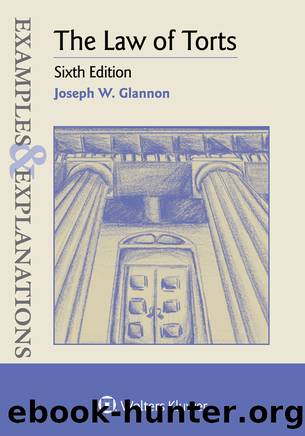Examples & Explanations for The Law of Torts by Glannon Joseph W

Author:Glannon, Joseph W.
Language: eng
Format: epub
Publisher: Wolters Kluwer
Published: 2020-01-15T00:00:00+00:00
RECAP AND CLOSING COMMENTS
The Second Restatementâs multifactor approach to strict liability has been embraced by a good many courts. The Third Restatement suggests a somewhat simpler analysis, but is largely consistent with the thrust of the Second. Under both formulas, strict liability should apply to activities so inherently dangerous that the level of risk will remain high despite all reasonable efforts to reduce it. If reasonable care can make the activity generally safe, courts will not impose strict liability. See Indiana Harbor Belt R.R. Co. v. Am. Cyanamid Co., 916 F.2d 1174, 1177 (7th Cir. 1990); see generally G. Boston, Strict Liability for Abnormally Dangerous Activities: The Negligence Barrier, 36 San Diego L. Rev. 597, 653-659 (1999). If reasonable care cannot eliminate a substantial risk of grave physical injury, strict liability will probably apply, even though the activity is socially valuable and conducted conscientiously. The defendantâs best argument to avoid strict liability in such cases is that the activity is one of âcommon usage.â Whether or not courts expressly adopt the Third Restatement formulation in place of the widely adopted Second Restatement, they will probably decide cases almost entirely on the two factors emphasized in the Third.
Abnormally dangerous activities are not the only example of strict liability in American tort law. The most common is strict products liability, which holds a manufacturer or seller strictly liable for injuries resulting from the sale of defective products. Strict products liability is based on different rationales than strict liability for abnormally dangerous activities, and requires proof of different elements. We will cope with its complexities in the next two chapters.
The examples below illustrate the application of strict liability for abnormally dangerous activities. In analyzing them, assume that the Third Restatement formulation applies, unless otherwise indicated.
Download
This site does not store any files on its server. We only index and link to content provided by other sites. Please contact the content providers to delete copyright contents if any and email us, we'll remove relevant links or contents immediately.
The Social Psychology of Inequality by Unknown(2312)
The Plant Paradox by Dr. Steven R. Gundry M.D(2043)
The Writing on the Wall by Anselm Jappe(1759)
Working for Yourself by J.D. (Nolo) Stephen Fishman(1479)
Every Landlord's Legal Guide by Janet Portman & Stewart Marcia & Ralph Warner(1326)
The First 20 Hours: How to Learn Anything ... Fast by Kaufman Josh(1304)
ADHD on Trial by Michael Gordon(1241)
Decisive by Chip Heath(1202)
Drafting Contracts: How and Why Lawyers Do What They Do, Second Edition by Stark Tina L(1174)
Working for Yourself by Stephen Fishman J.D. (Nolo)(1140)
The Economist Aug 8th 2015 by The Economist(1123)
Restitution by Restitution(1116)
The Economist Aug 29th 2015 by The Economist(1098)
A Practical Guide to International Arbitration in London by Hilary Heilbron(1085)
The Lord of the Rings: The Fellowship of the Ring, the Two Towers, the Return of the King by J. R. R. Tolkien(1083)
Intellectual Property Strategy by John Palfrey(1082)
Collusion by Luke Harding(1045)
Persuasion by Owner(1014)
Chapter 1 by Owner(950)
